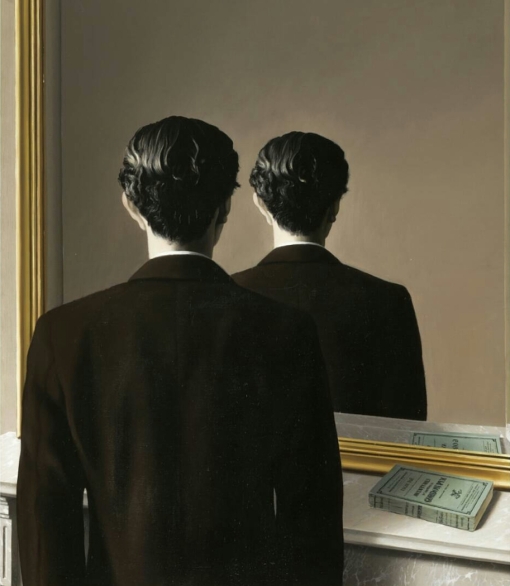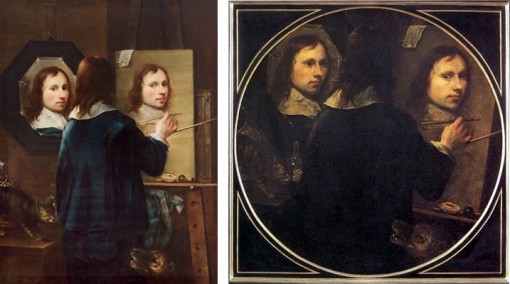“Reproduction interdite”

René Magritte. La réproduction interdite (1937)
The painting I’m going to review in this essay is “La reproduction interdite” created by René Magritte in 1937. It depicts Edward James, a poet and philanthropist who supported Magritte and his work for years, facing the mirror. The title of this painting contains a play of words assuming two ways of reading: “reproduction prohibited” and “prohibited reproduction”, where the latter can be understood as “impossible reproduction”.
In his book “Ceci n’est pas une pipe”, Michel Foucault points out one of Magritte’s ideas formulated in “Les mots et les images”, artist’s manifesto written in 1927: “Between words and objects one can create new relations and specify characteristics of language and objects generally ignored in everyday life.” In “La reproduction interdite”, Magritte applies the same principle creating a complex interaction between the picture and several forms of text introduced at different levels. At each of them, he puts the process of reproduction in opposition with its impossibility.
The most obvious opposition can be seen right in the center of the work: the mirror which is supposed to reflect/reproduce the face of the man standing in front of it, does not do its work. It shows him from the back literally translating both significations of the painting’s title. It obeys the prohibition of reproduction, hiding the poet’s face, and demonstrates an image impossible due to the laws of physics.
A text is also present within the picture itself, as in numerous works by Magritte, however not in the form of explicit statements, or of words replacing objects, like in his earlier series. Here he introduces it as the name of specific novel by Edgar Poe, “The narrative of Arthur Gordon Pym of Nantucket”, depicted on the cover of the book situated to the right side of the man. The inclusion of the Poe’s novel into the narrative gives rise to several interpretations of the concept of “reproduction” in this work of Magritte.
The first layer is the most evident and is certainly associated with the contradictory history of Poe’s work. “The narrative of Arthur Gordon Pym of Nantucket” was the only novel ever finished by Poe and was crushed by the critics because of its extremely strange form. The narrative starts as a realistic description of a journey to the South Pole based on actual travel notes and Poe’s own experience of sea travel, then becoming strange and absurd. Poe publicly disowned it, calling his work “the silliest book” and didn’t want it to be further distributed. Moreover, the novel itself contains a series of detailed copies of private travel notes, for which Poe even received an accusation of plagiarism. In this way, the presence of the book in the picture can be understood as a “prohibited reproduction” in several senses: as one which wasn’t desired or allowed by its author, and as one containing forbidden reproductions inside of it.
The second layer of interpretation relates to the objectivity of any object which can be reproduced an infinite number of times, such as an image, and especially a book which is an industrially produced item. Thus, the impossibility of prohibiting reproduction is declared.

Johannes Gumpp. Self-portrait (1646)
Meanwhile, a closer look at the ensemble of artist’s works suggests another interpretation of this painting. In many works of Magritte, drawn and real images are mixed up to be interchangeable, which suggests that the reflection in a mirror could turn into a painting. In this case, the conflict remains: formally, the reproduction took place, but the face is still hidden. This way of reading would attribute the Magritte’s gesture to the principle of “mise en abyme” broadly used in the classical painting, especially in artists’ self-portraits. In this sense, an interesting parallel could be traced between “La Reproduction interdite” and one of the the best-known, and the mostly reproduced self-portraits in the history of art: that of the Austrian painter Johannes Gumpp created in 1646. The location of the artist’s figure and other elements on his picture is compositionally similar to the arrangement of the figures in Magritte’s painting. At the same time, the “Self-portrait” contains both a mirror and a canvas, which are merged into one by Magritte. In this sense, as a representative of the avant-garde, Magritte rethinks the genre of portrait and self-portrait, trying to deprive it of its main characteristic feature, the concreteness of the image of a person – whether it is a mirror or a picture, a person does not see himself in it. In the context of the previous reflections on the painting’s title, it can also be understood as a statement of the meaninglessness of the visual reproduction.
No trackbacks yet.